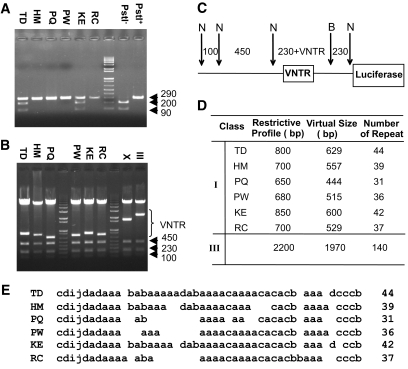FIG. 1.
Six novel class I VNTR alleles and the restriction profile of the class I and III alleles of the constructs. A: Six human genomic DNA samples were genotyped using the +1,127 PstI polymorphism. PstI+ (uncut by PstI) and PstI− (cut by PstI) variants are in strong linkage disequilibrium with diabetic class I and nondiabetic class III VNTR haplotypes, respectively (10). By designing a pair of primers (5′-TAAATGCAGAAGCGTGGCATTGTGGAAC-3′ and 5′-CTGCATGCTGGGCCTGGCCGG-3′), the PCR products amplified from genomic DNA were digested with PstI to generate a single band of 290 bp from class I homozygotes; two bands of 200 bp and 90 bp from class III homozygotes; and three bands of 290 bp, 200 bp, and 90 bp from I/III heterozygotes. TD and KE are heterozygous (I/III) and the other four are homozygous class I. PstI + and − are control DNA of class I and class III homozygotes, respectively. B: Restriction profile of the VNTR alleles contained in the reporter gene constructs. NcoI and BglII were used. C: Schematic explanation for the profile shown on the gel B or quantitated in table D. The band sizes are indicated by base pairs and marked by N (NcoI) and B (BglII); 230 + VNTR in C corresponds to VNTR in B or restriction profile in D. D: Estimation of the sizes of individual VNTR alleles. E: Sequence of six class I VNTR alleles in the format of repeat unit array and according to the convention set by previous reference (24). The number of repeat units is shown to the right of each sequence.

